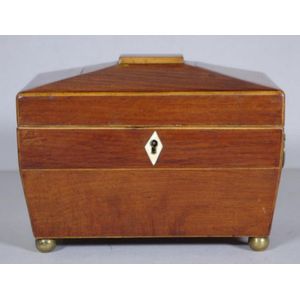Rosewood Tea Caddy with Boxwood Stringing and Brass Fittings
You must be a subscriber, and be logged in to view price and dealer details.
Subscribe Now to view actual auction price for this item
When you subscribe, you have the option of setting the currency in which to display prices to $Au, $US, $NZ or Stg.
- Circa - A Latin term meaning 'about', often used in the antique trade to give an approximate date for the piece, usually considered to be five years on either side of the circa year. Thus, circa 1900 means the piece was made about 1900, probably between 1895 and 1905. The expression is sometimes abbreviated to c.1900.
- Boxwood - Boxwood is a hard, yellow coloured, close grained timber. In the 19th century it was often used for inlays, especially stringing, because of its contrasting colour to the darker timbers of the carcase. Stringing is the inlay of a narrow strip of veneer of a lighter colour, such as boxwood along or close to the edges of an object that has been veneered in a darker timber such as mahogany.
Because of its fine grain and resistnce to splitting or chipping it has also been used for treen, turnings, carvings and other small wooden items, such as chess pieces. - William Iv - William IV was King of the United Kingdom and King of Hanover from 26 June 1830 until his death in 1837, and in English furniture design it represented the brief period between the end of the Regency period, and the beginning of the Victorian period.
- Rosewood - A dense timber that varies in shade to very light brown to almost black. When rosewood is cut and sanded the colour of the timber will turn black, and after polishing and exposure to daylight, the surface will gradually lighten over time to light brown with black streaks.
The name comes from the odour emanating from the timber when it is planed, sanded or cut.
Rosewood was very popular for use in Victorian furniture in the second half of the 19th century, and at that time most of the rosewood was imported from Brazil. However it also grows in India and Indonesia.
It is used in the sold for chairs and table legs, but for carcase furniture such as side cabinets and bookcases, and for table tops it is always used as a veneer.
This item has been included into following indexes:
Visually similar items

Regency rosewood tea caddy, of sarcophagus form, boxwood strung, twin lidded interior with ivory knobs, lion ring handles & claw feet, c1820, 18.5 cm x 11 cm, 14.5 cm

Regency Casuarina tea caddy, with sarcophagus shape, brass 'Basket of Fruit' side handles, interior inlaid with casurina lids and turned ivory handles on brass bun feet. 21 cm wide, 13.5 cm deep, 15.5 high

A Regency rosewood sarcophagus tea caddy with ring-drop handles and bun feet. Width 22 cm

A Regency rosewood tea caddy, plain sarcophagus form, mother-of-pearl- inlaid escutcheon, vacant interior. 28.5 cm x 13.5 cm x 15.5 cm
